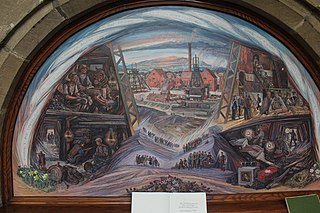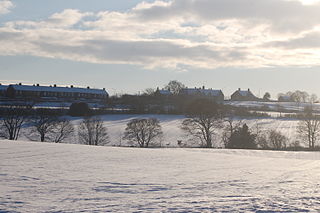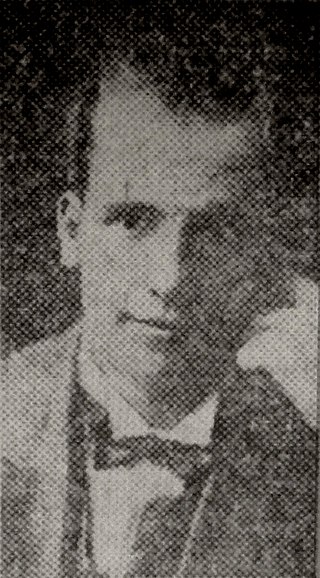Related Research Articles

Sacriston is a village and civil parish in County Durham, England, situated 3 miles (4.8 km) north of the city of Durham.
A safety lamp is any of several types of lamp that provides illumination in coal mines and is designed to operate in air that may contain coal dust or gases, both of which are potentially flammable or explosive. Until the development of effective electric lamps in the early 1900s, miners used flame lamps to provide illumination. Open flame lamps could ignite flammable gases which collected in mines, causing explosions; safety lamps were developed to enclose the flame and prevent it from igniting the surrounding atmosphere. Flame safety lamps have been replaced in mining with sealed explosion-proof electric lights.

The Gresford disaster occurred on 22 September 1934 at Gresford Colliery, near Wrexham, Denbighshire, when an explosion and underground fire killed 266 men. Gresford is one of Britain's worst coal mining disasters: a controversial inquiry into the disaster did not conclusively identify a cause, though evidence suggested that failures in safety procedures and poor mine management were contributory factors. Further public controversy was caused by the decision to seal the colliery's damaged sections permanently, meaning that only eleven of those who died were recovered.
Clifton Hall Colliery was one of two coal mines in Clifton on the Manchester Coalfield, historically in Lancashire which was incorporated into the City of Salford in Greater Manchester, England in 1974. Clifton Hall was notorious for an explosion in 1885 which killed around 178 men and boys.

Sir Richard Augustine Studdert Redmayne was a British civil and mining engineer. Redmayne worked as manager of several mines in Britain and South Africa before becoming a professor at the University of Birmingham. He was a leading figure in improving mine safety in the early twentieth century and would become the first Chief Inspector of Mines, leading investigations into many of the mine disasters of his time. He became the president of three professional associations, namely the Institution of Mining and Metallurgy, the Institution of Professional Civil Servants and the Institution of Civil Engineers.
Matthias Dunn was a British mining engineer and one of the first government inspectors of mines. He was known for encouraging safe practices in mines.

Gresford Colliery was a coal mine located a mile from the North Wales village of Gresford, near Wrexham.

Marley Hill is a former colliery village about six miles to the south west of Gateshead, near the border between Tyne and Wear and County Durham. It has been part of the Metropolitan Borough of Gateshead since 1974. Prior to this it was part of Whickham Urban District. It lies within the Whickham South & Sunniside electoral ward of the Blaydon parliamentary constituency.
Sir Andrew Meikle Bryan was a Scottish mining engineer and academic.
Sir Henry Walker CBE was the Chief Inspector of Mines for Great Britain in the 1930s, most notable for leading the enquiry into the Gresford Colliery Disaster of 1934. In his younger days he was a rugby player of some note playing at county level and representing the Barbarians.

Joseph Jones was a British trade unionist.
Sir William Galloway was a Scottish mining engineer, professor and industrialist.
Robert Lindsay Galloway was a Scottish mining engineer and author, the son of William Galloway (1799–1854), a Paisley shawl manufacturer and coal master and Margaret Lindsay (1818–1902) daughter of Thomas Lindsay, a Glasgow brewer. He was born in Paisley, Scotland
Edmund Mills Hann (1850–1931) was a Welsh prominent figure in the industrial life of South Wales, and a leading coal owner during the industrial struggles of the 1920s.

Edward Fenwick Boyd was an English industrialist who became the fourth President of the North of England Institute of Mining and Mechanical Engineers (NEIMME). He held a leading role in the Mining Institute from its inauguration in 1852 as Treasurer and a member of the council before becoming the fourth president in 1869. As president, Boyd oversaw the installation of the Nicholas Wood Memorial Hall and the Newcastle College of Physical Science.
Andrew Kirkwood McCosh, J.P., D.L. was an administrator in the coal and steel industries, born in Ayrshire, Scotland.
The Institution of Mining Engineers (IMinE) was a former British professional institution.
Sir Herbert Henry Merrett was a Welsh industrialist. In his teens he won a reputation as a footballer and played for the Cardiff Corinthians, a prestigious amateur soccer team, and he subsequently qualified as a referee. He was appointed chairman of the Cardiff City Association Football Club in 1939 and with one short break, and despite his business involvement, he remained chairman until 1957.
Joseph Parker FRSE MIME (1871–1940) was a Scottish mining engineer and educator.

Bentley Colliery was a coal mine in Bentley, near Doncaster in South Yorkshire, England, that operated between 1906 and 1993. In common with many other mines, it suffered disasters and accidents. The worst Bentley disaster was in 1931 when 45 miners were killed after a gas explosion. The site of the mine has been converted into a woodland.
References
- ↑ anon 1947.
- 1 2 3 DMM 2016.
- 1 2 3 4 5 6 DMM 2018.
- ↑ Mine Inspectors Report 1903.
- ↑ Baker 2018.
- ↑ The_Science & Art of Mining 1929, p. 6.
- ↑ The Science & Art of Mining 1935, p. 155.
- 1 2 3 4 Walker, Brass & Jones 1937.
- ↑ "Hansard" 1937.